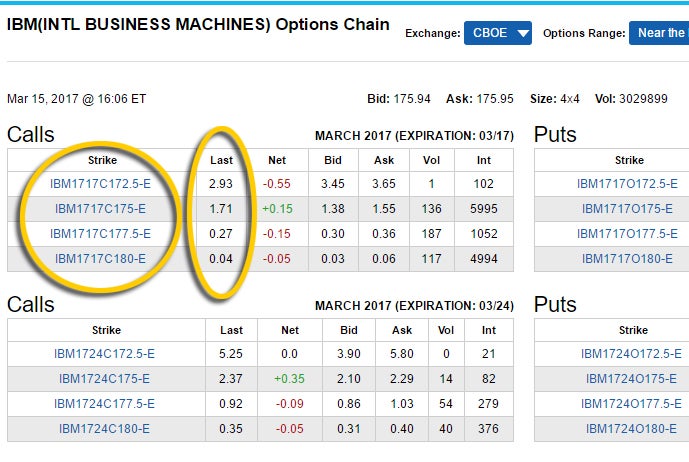The price, or cost, of an option is an amount of money known as the premium. The buyer pays the premium to the seller in exchange for the right granted by the option. For example, a buyer might pay a seller for the right to purchase 100 shares of stock XYZ at a strike price of $60 on or before May 19. If the position becomes profitable, the buyer will decide to exercise the option; if it does not become profitable, the buyer will let the option expire worthless. The buyer pays the premium so that he or she has the "option" (or the choice) to either exercise or allow the option to expire worthless.
Premiums are priced per share. For example, the premium on an IBM option with a strike price of $172.50 might trade at $2.93, as shown in Figure 1, below. Since equity options are based on 100 stock shares, this particular contract would cost the buyer $2.93 X 100, or $293 dollars. The buyer pays the premium whether or not the option is exercised, and the premium is non-refundable. The seller gets to keep the premium either way.
 |
|
Figure 1 Part of the option chain for the March 2017 IBM contract, which shows some of the premiums and strike prices. Chart created at CBOE.com. |
An option premium is its cost – how much the particular option is worth to the buyer and seller. While supply and demand ultimately determine price, other factors, which will be discussed later in this tutorial, do play a role. Option traders apply these factors to mathematical models to help determine what an option should be worth.
Options Pricing: Intrinsic Value and Time Value
-
 Trading
TradingOption trading strategies: A guide for beginners
Options offer alternative strategies for investors to profit from trading underlying securities. Learn about the four basic option strategies for beginners. -
 Trading
TradingBeginners Guide To Options Strategies
Find out four simple ways to profit from call and put options strategies. -
 Investing
InvestingWhy Options Trading Is Not for the Faint of Heart
Trading options is not easy and should only be done under the guidance of a professional. -
 Trading
TradingOption Strategies For A Down Market
All investors should be aware that the best time to buy stocks is when the market is tanking, according to history.



